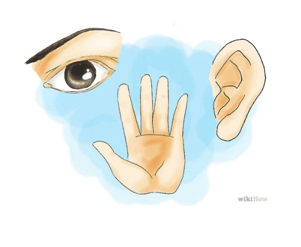Lesson 6: Methods of communication
Attention

Learning Outcomes
Upon completion of this lesson's material, students will be able
-
Identify how language, literacy and literature development is influenced and impacted by the five senses.
-
Explain the difference of receptive and expressive language and how it is impacted by the five senses.
Teaching
Most humans use the five senses of sight, hearing, taste, touch and smell to communicate.
Sight
Through our eyes we receive visual signals that include facial expressions, gestures and body language. In early childhood it is important to get down on the child’s level when talking with them and make eye contact to be sure they present with you. In the still face experiment video you will be watching this week, you will see how the visual signals the baby is receiving is plays a large part in how the baby communicates to her mother and can be a little uncomfortable to watch.
Hearing
Our eyes are not the only senses that receive information about the world around us. Our ears receive a messages that are made through sounds. In early childhood, these sounds could be words but also utterances, gasps, volume, tones and pitch. Although newborns may not understand the words quite yet, they do understand the way in which we say the words.
Taste
Taste is another sense we use to communicate. Taste may not be quite as obvious as the other senses but if you have ever worked with infants and toddlers, you would know that they tend to put everything in their mouth. By tasting the object, toddlers receives important information about the object. They find out if the object is sweet, sour, bitter salty or bland. It is important to note here that when toddlers put objects in their mouths, it does not always mean they are teething. It is very likely they are just exploring the world around them. This is OKAY! (Of course, make sure it is not a choking hazard and sanitary).
Touch
We often communicate our emotions through touch. We hug children to show them we care or are happy to see them. We rock the infants to sleep in our arms. Sometimes we put a reassuring hand on a child’s shoulder. We also use touch to write words and communicate through writing or use touch to get a child’s attention by touching the child’s shoulder.
Smell
Lastly, smell sometimes is our first sense that communicates information to us. We could smell smoke from a fire or a poopy diaper. These scents tell us that there is danger or there is a child who needs to be changed. On a more pleasant note, we could smell pizza and it triggers our stomach to growl and let us know we are hungry.
Receptive & Expressive Language
To break this down the senses even further, communication can be separated out into receptive and expressive language. Receptive language is how we receive the information and it helps us to understand the information we perceive. Expressive language is the “output” of the information we have. It helps us to convey a message or emotion. Both receptive and expressive language are necessary to have conversations and are impacted by our senses on a deeper level. When viewing the videos, watch how the people in the videos use five senses to communicate by receiving and expressing language.
For this assignment, you will need to
Watch
-
The Still Face Experiment (Video embedded below. If you are unable to watch the embedded video, you can watch it here.)
-
The Many Languages of children (Video embedded below. If you are unable to watch the embedded video, you can watch it here.)
Assessment
Lesson 6 Quiz – Identifying Communication indicators
-
Provide an example of how the people in the videos used sight, hearing, taste, touch and smell to communicate. Explain the importance of the sense and what might happen if they were not able to use their senses to communicate.
-
Provide two examples of receptive language and what senses the people in the videos used to receive the information. Explain the importance of receptive language.
-
Provide two examples of expressive language and what sense the people in the video used to express the information. Explain the importance of expressive language.